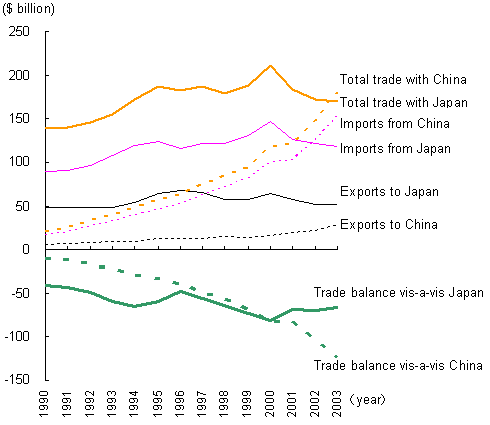China has been working to integrate itself into the global economy through trade liberalization and the receiving of foreign direct investment ever since it launched its market-opening reforms; and this pace has quickened since its entry into the World Trade Organization in 2001. Exports in 2003 grew by 34.6% up on the previous year to $438.37 billion, while imports rose 39.9% year-on-year to $412.84 billion. Total trade for the year came to $851.21 billion, putting China slightly ahead of Japan, whose trade totaled $851.17 billion. As a result, China has in one leap surpassed Britain, France and Japan to become the world's third-largest trading power after the United States and Germany (table). However, in view of the fact that China is greatly dependent on foreign capital and processing trade, such figures need to be taken with a pinch of salt when evaluating the country's real strength.
Foreign companies have played the greatest role in the expansion of China's trade. Since 1979, investment in China by foreign firms, including those based in Taiwan and Hong Kong, has exceeded $500 billion in total, and foreign companies now account for 30% of China's industrial production. Thanks to the participation of foreign companies, the percentage of industrial products in China's total exports now exceeds 90%. Exports and imports by foreign firms in 2003 increased by 41.4% and 44.7%, respectively, and comprise 54.8% and 56.2% of the total figures. In addition, 80% of the exports and 60% of the imports of foreign companies are categorized as processing trade. Processing trade here points to the provision of raw materials by foreign firms to Chinese companies, which receive payment upon delivering products they have manufactured by processing the materials based on the quality and design requirements of the foreign companies. In order to promote exports, China has given preferential treatment such as tax breaks to foreign companies and firms involved in processing trade, and many multinational corporations are using China as a production base for exports by utilizing such preferential treatment and China's cheap labor.
Against such a backdrop, China is becoming increasingly important as a trading partner for industrialized nations such as Japan and the U.S. For Japan, China has already surpassed the U.S. to become the largest source of its imports, and in terms of total trade, China is now its second-largest trading partner after the U.S. This trend of recent years is expected to continue, and the day will soon come when China becomes Japan's largest trading partner. On the other hand, the U.S. trade deficit vis-a-vis China exceeded that with Japan for the first time in 2000 (diagram). Following this, in 2002 imports from China exceeded those from Japan, and in 2003 the positions of Japan and China were reversed in terms of total trade. As a result, China has become the third-largest trading partner of the United States, after Canada and Mexico. However, because China's exports are concentrated in labor-intensive goods and processes, rapid expansion has brought about a deterioration in China's terms of trade through a decline in export prices (so-called China-induced deflation) as well as an escalation of trade frictions with trading partners.
In view of this surge in its trade, China has come to be called the "workshop of the world," or the "market of the world." However, on the production front, one cannot but say that China's industrial power is still weak, given such facts as the lack of its own technology, brands and distribution channels in overseas markets. On the demand side, China's imports center more on intermediate goods such as parts than final consumer goods, and most of the products manufactured by processing those goods are exported. In the first place, China's GDP, at $1.41 trillion in 2003, is still just one-third of that of Japan ($4.28 trillion), while per capita GDP has just recently topped $1,000, a scant one-thirtieth of that of Japan. When such facts are taken into consideration, it would be wrong for Japan to view China's transformation into the "workshop of the world" as a threat, but it would also be unrealistic to expect China to become the "market of the world" anytime soon.
Table: The world's top traders | |
 | |
(Souce) | Based on the customs statistics of each country |
| Diagram: | China has surpassed Japan as the third largest trading partner of the U.S. |
 | |
(Souce) | Based on U.S. customs statistics |


